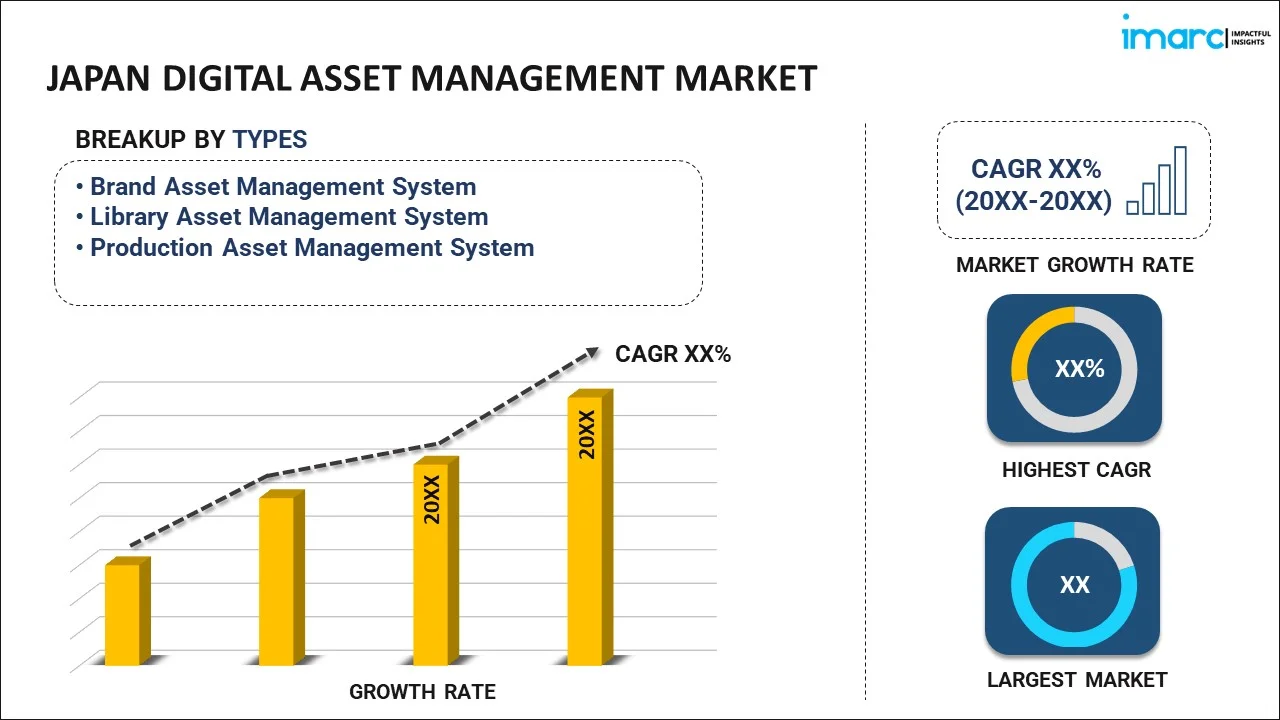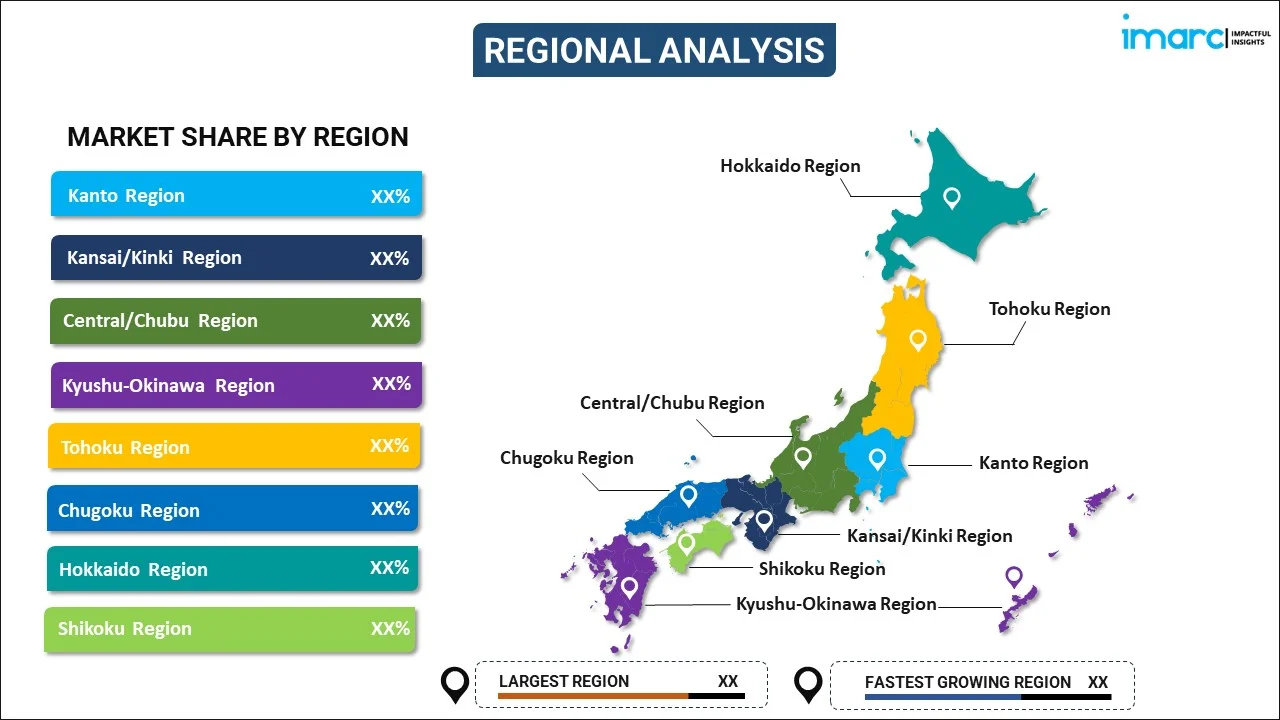
Japan Digital Asset Management Market Report by Type (Brand Asset Management System, Library Asset Management System, Production Asset Management System), Component (Solution, Services), Application (Sales and Marketing, Broadcast and Publishing, and Others), Deployment (On-premises, Cloud), Organization Size (Small and Medium-sized Enterprises, Large Enterprises), End Use Sector (Media and Entertainment, Banking, Financial Services and Insurance (BFSI), Retail, Manufacturing, Healthcare and Life Sciences, Education, Travel and Tourism, and Others), and Region 2025-2033
Market Overview:
Japan digital asset management market size reached USD 425.2 Million in 2024. Looking forward, IMARC Group expects the market to reach USD 1,044.3 Million by 2033, exhibiting a growth rate (CAGR) of 9.6% during 2025-2033. The increasing adoption of cloud-based digital asset management systems, which offer scalability, accessibility, and cost-effectiveness, thereby allowing businesses to streamline their operations and access assets from anywhere, at any time, is driving the market.
|
Report Attribute
|
Key Statistics
|
|---|---|
|
Base Year
|
2024 |
|
Forecast Years
|
2025-2033
|
|
Historical Years
|
2019-2024
|
| Market Size in 2024 | USD 425.2 Million |
| Market Forecast in 2033 | USD 1,044.3 Million |
| Market Growth Rate (2025-2033) | 9.6% |
Digital asset management (DAM) refers to the practice of organizing, storing, and retrieving rich media assets such as images, videos, audio files, and documents in a centralized digital repository. It streamlines the management of digital content, enabling businesses to efficiently store, share, and repurpose assets across various platforms and channels. DAM systems provide robust features for metadata tagging, version control, and rights management, facilitating easy search and retrieval of assets. They also support collaborative workflows, allowing teams to collaborate seamlessly on projects and campaigns. DAM solutions play a critical role in enhancing brand consistency, improving productivity, and ensuring regulatory compliance. Additionally, they offer scalability and integration capabilities, empowering organizations to adapt to evolving digital trends and technologies. Overall, DAM serves as a crucial tool for businesses looking to streamline their digital content management processes and maximize the value of their digital assets.
Japan Digital Asset Management Market Trends:
The digital asset management market in Japan is witnessing unprecedented growth, primarily driven by the exponential surge in digital content creation, as well as the escalating demand for effective content organization and retrieval. Consequently, as companies continue to prioritize digital transformation initiatives, the need for efficient DAM solutions has become increasingly pronounced. Moreover, the proliferation of cloud-based technologies has significantly fueled the adoption of DAM systems, enabling seamless accessibility and streamlined collaboration across geographically dispersed teams. In addition to this, the mounting significance of data security and compliance regulations has propelled organizations to invest in robust DAM platforms, ensuring the protection and governance of valuable digital assets. Furthermore, the integration of advanced artificial intelligence and machine learning capabilities within DAM software has amplified its appeal, facilitating automated metadata tagging and content personalization, thereby enhancing user experience and accelerating content delivery. Consequently, these collective market drivers are fostering a fertile landscape for the continued expansion and innovation within the regional digital asset management sector.
Japan Digital Asset Management Market Segmentation:
IMARC Group provides an analysis of the key trends in each segment of the market, along with forecasts at the country level for 2025-2033. Our report has categorized the market based on type, component, application, deployment, organization size, and end use sector.
Type Insights:

- Brand Asset Management System
- Library Asset Management System
- Production Asset Management System
The report has provided a detailed breakup and analysis of the market based on the type. This includes brand asset management system, library asset management system, and production asset management system.
Component Insights:
- Solution
- Services
- Consulting
- System Integration
- Support and Maintenance
A detailed breakup and analysis of the market based on the component have also been provided in the report. This includes solution and service (consulting, system integration, and support and maintenance).
Application Insights:
- Sales and Marketing
- Broadcast and Publishing
- Others
The report has provided a detailed breakup and analysis of the market based on the application. This includes sales and marketing, broadcast and publishing, and others.
Deployment Insights:
- On-premises
- Cloud
A detailed breakup and analysis of the market based on the deployment have also been provided in the report. This includes on-premises and cloud.
Organization Size Insights:
- Small and Medium-sized Enterprises
- Large Enterprises
The report has provided a detailed breakup and analysis of the market based on the organization size. This includes small and medium-sized enterprises and large enterprises.
End Use Sector Insights:
- Media and Entertainment
- Banking, Financial Services and Insurance (BFSI)
- Retail
- Manufacturing
- Healthcare and Life Sciences
- Education
- Travel and Tourism
- Others
A detailed breakup and analysis of the market based on the end use sector have also been provided in the report. This includes media and entertainment, banking, financial services and insurance (BFSI), retail, manufacturing, healthcare and life sciences, education, travel and tourism, and others.
Regional Insights:

- Kanto Region
- Kansai/Kinki Region
- Central/ Chubu Region
- Kyushu-Okinawa Region
- Tohoku Region
- Chugoku Region
- Hokkaido Region
- Shikoku Region
The report has also provided a comprehensive analysis of all the major regional markets, which include Kanto Region, Kansai/Kinki Region, Central/ Chubu Region, Kyushu-Okinawa Region, Tohoku Region, Chugoku Region, Hokkaido Region, and Shikoku Region.
Competitive Landscape:
The market research report has also provided a comprehensive analysis of the competitive landscape. Competitive analysis such as market structure, key player positioning, top winning strategies, competitive dashboard, and company evaluation quadrant has been covered in the report. Also, detailed profiles of all major companies have been provided.
Japan Digital Asset Management Market Report Coverage:
| Report Features | Details |
|---|---|
| Base Year of the Analysis | 2024 |
| Historical Period | 2019-2024 |
| Forecast Period | 2025-2033 |
| Units | Million USD |
| Scope of the Report | Exploration of Historical and Forecast Trends, Industry Catalysts and Challenges, Segment-Wise Historical and Predictive Market Assessment:
|
| Types Covered | Brand Asset Management System, Library Asset Management System, Production Asset Management System |
| Components Covered |
|
| Applications Covered | Sales and Marketing, Broadcast and Publishing, Others |
| Deployments Covered | On-premises, Cloud |
| Organization Sizes Covered | Small and Medium-sized Enterprises, Large Enterprises |
| End Use Sectors Covered | Media and Entertainment, Banking, Financial Services and Insurance (BFSI), Retail, Manufacturing, Healthcare and Life Sciences, Education, Travel and Tourism, Others |
| Regions Covered | Kanto Region, Kansai/Kinki Region, Central/ Chubu Region, Kyushu-Okinawa Region, Tohoku Region, Chugoku Region, Hokkaido Region, Shikoku Region |
| Customization Scope | 10% Free Customization |
| Post-Sale Analyst Support | 10-12 Weeks |
| Delivery Format | PDF and Excel through Email (We can also provide the editable version of the report in PPT/Word format on special request) |
Key Questions Answered in This Report:
- How has the Japan digital asset management market performed so far and how will it perform in the coming years?
- What has been the impact of COVID-19 on the Japan digital asset management market?
- What is the breakup of the Japan digital asset management market on the basis of type?
- What is the breakup of the Japan digital asset management market on the basis of component?
- What is the breakup of the Japan digital asset management market on the basis of application?
- What is the breakup of the Japan digital asset management market on the basis of deployment?
- What is the breakup of the Japan digital asset management market on the basis of organization size?
- What is the breakup of the Japan digital asset management market on the basis of end use sector?
- What are the various stages in the value chain of the Japan digital asset management market?
- What are the key driving factors and challenges in the Japan digital asset management?
- What is the structure of the Japan digital asset management market and who are the key players?
- What is the degree of competition in the Japan digital asset management market?
Key Benefits for Stakeholders:
- IMARC’s industry report offers a comprehensive quantitative analysis of various market segments, historical and current market trends, market forecasts, and dynamics of the Japan digital asset management market from 2019-2033.
- The research report provides the latest information on the market drivers, challenges, and opportunities in the Japan digital asset management market.
- Porter's five forces analysis assist stakeholders in assessing the impact of new entrants, competitive rivalry, supplier power, buyer power, and the threat of substitution. It helps stakeholders to analyze the level of competition within the Japan digital asset management industry and its attractiveness.
- Competitive landscape allows stakeholders to understand their competitive environment and provides an insight into the current positions of key players in the market.
Need more help?
- Speak to our experienced analysts for insights on the current market scenarios.
- Include additional segments and countries to customize the report as per your requirement.
- Gain an unparalleled competitive advantage in your domain by understanding how to utilize the report and positively impacting your operations and revenue.
- For further assistance, please connect with our analysts.
 Inquire Before Buying
Inquire Before Buying
 Speak to an Analyst
Speak to an Analyst
 Request Brochure
Request Brochure
 Request Customization
Request Customization




.webp)




.webp)












